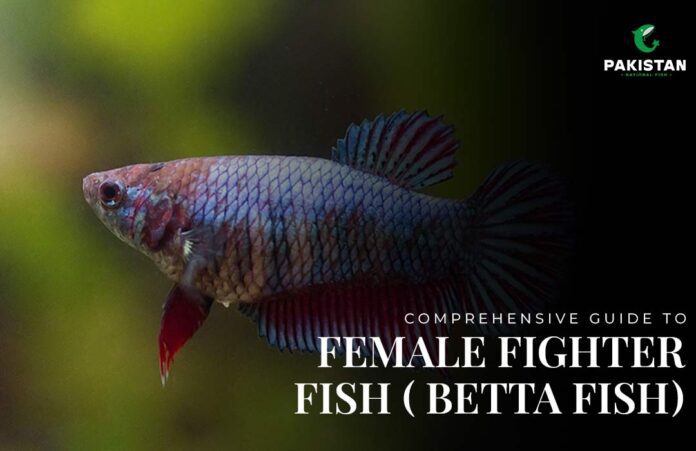Female Betta fighting fish are excellent pets you can instruct to perform simple tasks! These fish are strong, but they still require a lot of careful loving care to live the happiest, healthiest lives imaginable.
While male betta fish, also known as fighter fish or Siamese fighting fish, seem to get all the attention, their female counterparts remain a hidden gem in the world of fish aquarium hobbyists due to an absence of knowledge and unpopularity. In this post, we will cover everything connected to female betta fish, giving you vital knowledge and insight to help you care for these lovely aquatic creatures and change your female betta fish aquarium.
History & Origin of Female Fighter Betta Fish
Betta fish originated in Southeast Asia, notably Thailand, Cambodia, Vietnam, and Malaysia. They live in shallow, sluggish environments like rice fields, ponds, and streams. Bettas were traditionally bred for fighting because of their aggressive attitude. Over the years, selective breeding has improved its colors and fin forms, resulting in the stunning variations we see today.
Female Betta Fish Appearance
Female Bettas, unlike male Bettas, have a variety of patterns and colors. They have long, floating fins that can take on many different shapes and colors. However, female bettas often have smaller fins and less elaborate finnage than those who are males.
Behaviors
Female bettas are recognized for being gentler than male bettas, allowing for more aquarium configuration options. They are frequently kept in groups known as sororities, which can provide a dynamic social aspect to their treatment.
1. Sororities
Sororities are groups of at least five female bettas who share a living space. This number serves to spread aggression and build a hierarchy, limiting the likelihood of any single fish being significantly attacked.
2. Territorial
Female bettas, while less aggressive, can still show aggressive behavior, particularly when introduced to a new tank. Providing a variety of hiding places and plants will help reduce this.
Establishing a Perfect Aquarium Environment
Providing the optimal habitat for female bettas is important for their wellness and health.
- Aquarium Size: A single female betta should have a tank no smaller than 10 gallons. A sorority should have a tank that is at least 20 gallons. Female bettas flourish in warm water with degrees ranging from 76 to 82°F (24 to 28°C). The recommended pH range is 6.5-7.5, and the water hardness should be modest.
- Filtering and Aeration: Bettas enjoy calm water, thus a moderate filter is required. Aeration is less important because bettas have a labyrinth organ that permits them to breathe atmospheric air.
- Foundation and Decorations: To preserve their fins, use soft ground such as sand or fine gravel. Adding lots of fish aquarium plants, caverns, and decorations creates hiding places and minimizes stress.
Diet and Nutrition
Female bettas are carnivorous and need a protein-rich diet.
- Market Foods: High-quality betta pellets and flakes ought to serve as the foundation of their diet.
- Live and Frozen Foods: Increase their diet with live or frozen meals such as brine shrimp, bloodworms, and algae to improve nutrition and drive natural hunting instincts.
- Feeding Duration: Female bettas should be fed fish feed once or twice a day, with only as much as they can swallow in 2-3 minutes to prevent overfeeding and problems with water quality.
The Breeding Process
Betta breeding may be both rewarding and demanding.
- Selection: Select healthy, colorful fish for breeding. Males must possess long, flowing fins, while females must be robust with obvious egg spots.
- Breeding Tank: Create an individual breeding tank with water that is shallow, perhaps 5-6 inches deep, and plenty of hiding places for the female.
- Breeding Process: Using a transparent divider, transfer the female to the male’s tank. Once the male has created a bubble nest, get rid of the partition and allow the pair to communicate. To avoid aggressive behavior, remove the female after spawning.
Different Kinds of Female Fighter Betta Fish
Female fighter betta fish, like male betta fish, come in a variety of colors and have sharp tails.
- Wild Female Betta: These are the most similar in looks to wild betta splendens.
- Veiltail Female Betta: Veiltail females have lengthy flowing fins that are less showy or intricate than those of male Veiltail Bettas.
- Crowntail Female Betta: Crowntail female Bettas have unusual fins.
- Halfmoon Female Betta: When completely extended, their fins form a circular shape or “D” shape.
- Doubletail Female Betta: Doubletail female bettas have a genetic abnormality that results in two unique tails instead of one.
- Plakat Female Betta: Plakat female Bettas, commonly known as short-tail females, possess shorter fins than other Betta species.
Conclusion
Female fighter fish make fascinating and satisfying pets, with distinct habits and relationships when compared to their male counterparts. Aquarists can appreciate the beauty and character of female bettas, whether as lonely pets or in vibrant sororities, by recognizing their needs and offering appropriate care. Female bettas, with their endurance and charm, are an excellent complement to any aquarium.


